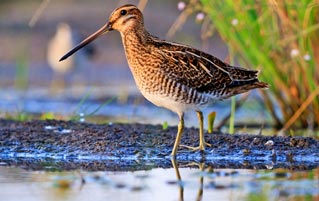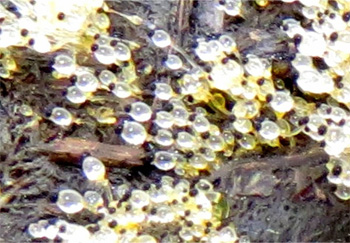5 Small-Ass Animals With Huge-Ass Powers

Despite what many a woman has told her ex-boyfriend, size doesn't always matter. Little things can make a huge difference. Just look to nature. Oh, but it's not the blue whales and the rhinos you should be watching -- it's the creatures so small you could not only step on them; you'd barely slow down to scrape them off your shoe. Like ...
Water Boatmen Are One Of The Loudest Animals Alive
Water boatmen are barely the size of a grain of rice. But don't dismiss them, because they hold an impressive record: They're one of the loudest animals on earth. And they do it all ... with their dicks. See, whenever a male boatman sees a magnificent specimen of the opposite sex strutting around the pond, it whips out its bug schlong and begins rubbing it against its belly -- a scene you have no doubt witnessed on the subway. Every single morning.
For the train-bound pervert, this produces sticky fluids and police charges. For the boatman, this produces a mating call. One that is literally louder than a jackhammer.

Can you imagine how awkward masturbation would be if that happened to you?
A water boatman's dong-drumming session peaks at a stunning 105 decibels. When scientists first registered this epic wang-chun, they ran more tests just to make sure Randy the intern didn't get high and mess with all of their equipment. But, no, it turns out that boatmen just live life loud -- so much so that a casual passerby can hear their cock concerto, even if the bug is sitting at the bottom of a huge body of water.

"Anyway, here's Bonerwall."
That water is actually why people don't go deaf from the boatman's literal boner jams: the H20 absorbs 99 percent of the pre-jackhammering jackhammering.
Salps Form Colonies The Size Of Countries
Salps are transparent, gelatinous sea organisms that usually don't grow larger than four inches. They're not exactly impressive ...

"Oh, yeah? Well at least when someone says size doesn't matter to us it's actually true."
But sometimes trillions of them will come together to form huge oceanic swarms, and that's when things get serious. See, thanks to the salps' ability to grow as much as 10 percent of their body length per hour, one of those clusters can reach 38,600 square miles. That's like 18,500,000 football fields, or just about the size of South Korea. Ordinarily, this would be the point we start panicking and advocate ill-advised but enthusiastic napalm deployment, but Salps do something pretty cool: They consume carbon dioxide.
The oceans actually absorb a lot of CO2 from the atmosphere, where it's eventually eaten by phytoplankton (organisms even tinier than salps) before being released back into the air when the animals die. Salps help with that by eating the phytoplankton themselves, and pooping out the CO2 in pellets that sink to the bottom, where the gas can't warm up the planet and or/be dismissed as a liberal conspiracy.

"When's the last time your poop caused anything but tears and despair?"
The Hat-Thrower Fungus Ejaculates Like A Rocket
Pilobolus crystallinus are tiny fungi that grow in the poop of various grass-eating animals, such as cows and horses. It's also known as the hat-thrower fungus -- mostly because that sounds less gross than "megasonic cumshot fungus."
Pilobolus is a near-microscopic cannon capable of shooting its spores (those little black "hats") further than six feet when it reproduces. This would be like a guy of average height standing on the ground and ejaculating so hard that his sperm nails the top of the Empire State Building. Please don't try this, by the way.
Pilobolus spores accelerate faster than an actual rocket. 42,500 times faster, to be exact. That's 1.7 million meters per second squared. That technically makes the hat-thrower the fastest organism/orgasmer on the planet, because their cumshots clock in at roughly 55 miles per hour.

Oddjob doesn't even throw his hat that fast.
Human ejaculation, on the other hand, doesn't quite break 30mph -- although frankly, that still sounds pretty awesome. We fire little dudes so fast they'd get a speeding ticket.
In a school zone.
But still!
The Great Snipe Can Fly Up To 4,200 Miles At 60MPH -- Without Stopping
Despite sort of looking like a fat, depressed woodpecker, the great snipe (Gallinago media) is the fastest endurance flier on the planet.

Also, they're all named Leonard. We mean ... just look at this Leonard over here.
The snipe undertakes an annual migration from Northern Europe to Sub-Saharan Africa -- 4,200 miles -- and it does the whole journey in one non-stop two-day trip, averaging 60mph. Now, while they are amazed at the birds' journey, scientists are generally confused about why the great snipe is in such a hurry. Unlike other far-flying birds that cross oceans (and have no place to stop), the chubby snipe's migratory route is mostly over land. There is literally no reason they don't stop to rest along the way.
They just live their lives a quarter mile at a time.
A Mite From Southern California Could Run At Mach 2 (If It Was Bigger)
Paratarsotomus macropalpis is a mite from Southern California. Since scientific names of animals are unwieldy, we're going to call it mighty mite. You'll see why in a second.

And it's not because it's big.
The mighty mite travels an astounding 322 body lengths per second (compared with the cheetah's measly 16). Now, due to the mites' minuscule size, that only comes out to about 0.5 miles per hour -- but if the mite was the size of Usain Bolt, it would hit nearly Mach 2. Most animals that hit crazy high speeds do so at the cost of maneuverability, but not the mighty mite. On the end of the mite's third leg, there's a barb that functions like an adorable grappling hook -- allowing it to change orientation by up to 1253 degrees per second. You may have seen this trick before -- on the mothafuggin' Batmobile.

"Na-na-na-na-na-na-na-na-NIGHTMARES!"
Also check out 5 Tiny Animals That Deserve Their Own Horror Movie and The 6 Deadliest Creatures (That Can Fit In Your Shoe).
Subscribe to our YouTube channel, and check out The 4 Most Adorable Animal Rampages, and other videos you won't see on the site!
Follow us on Facebook, and we'll follow you everywhere.